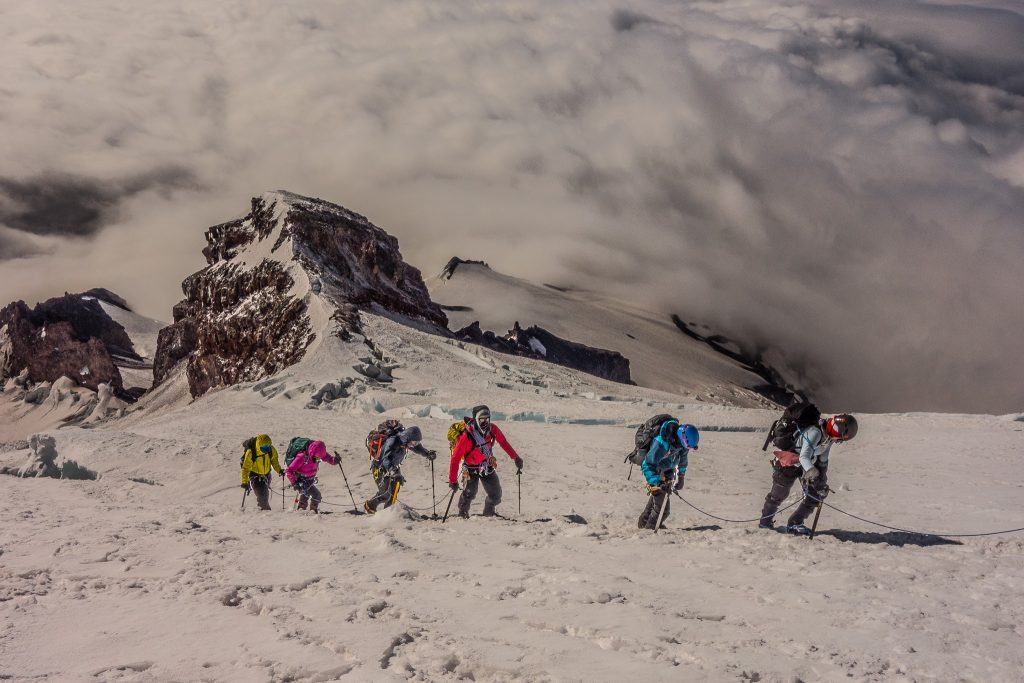Mount Baker
Also known as Koma Kulshan is the second-most thermally active crater in the Cascade range after Mount Saint Helens.
Elevation: 10,781 feet
Number of days on a trip: 2-3 days
Routes used: Coleman Deming or Easton Glacier route based on the snow conditions of the mountain and the time of the year.
Mount Shuksan
It may be the ninth-highest in the Washington state but is a huge glaciated massif as the name suggests in Lummi. It is also the most photographed mountain the Cascades. Climbing it surrounds you with the hike through a pristine forest, a moderate glacier to exhilarating achievement for the one who stands on the summit ledge.
Elevation: 9,131 feet
Number of days on a trip: 2-3 days
Routes used: Sulphide Glacier. Climbers will need to have some experience with scrambles or willing to actively participate in ‘Intro to Rock’ provided by a number of climbing organizations and guiding companies in the area.
Mount Rainier
It is not only the tallest mountain in the Washington state but also is the most glaciated mountain in the lower 48 states. It is also called as Tahoma or rather to say ‘mother of water’ in Salishan.
Elevation: 14,411 feet
Number of days on a trip: 3-4 days
Routes used: Disappointment Cleaver (DC) or Emmons-Winthrop are the basic routes typically used to reach the summit. DC route does provide a challenge with objective hazards with sea od climbers on the route while Emmons route is less prone to objective hazard but has route finding challenges. Overall, we choose the route based on the snow conditions and best information available to the rangers to help the chances for our climbers to succeed. It should be noted that although Emmons route might be safer at times, it is a bit longer and has more elevation gain to achieve on your feet as you start hiking from lower elevations at White River Campground and also camp at approximately 9,500 feet rather than at Camp Muir or Ingrahm Flats when on DC route.
Glacier Peak
Glacier Peak or Dakubed is the most remote/isolated of the major 5 stratovolcanoes of the Cascades in the state of Washington. It is known to provide the climbers with pristine landscape and backpacking into mountaineering experience including a section of glacier travel on the summit day.
Elevation: 10,541 feet
Number of days on a trip: 4 days
Asha supports various projects all over India; here’s a summary of the work supported by the climb fundraiser for the GRAVIS project. Asha has supported various projects for GRAVIS (Gramin Vikas Vigyan Samiti) since 2008. GRAVIS operates in the Thar Desert region, near Jodhpur, Rajasthan. The Thar Desert, spread across the state of Rajasthan mainly, is one of the most underdeveloped regions in India. The local people depend on rain-fed agriculture for their livelihood. Scanty rainfall and persistent droughts add to the vulnerability of these communities. Due to gender disparity, women and girls are most affected by the lack of water security, poverty, lack of education.
GRAVIS with the support of Asha for Education has come up with an integrated solution which addresses water security, food security, healthcare, and education. The project, “Water, health, and education for Women and Children in Thar” covers 6 drought-hit villages of Jodhpur district of Rajasthan, India.
- Water Security: Most of Asha funds support constructing rain-water harvesting systems like taankas (underground tank). We’ve also supported Khadins (earthen-bund). From 2009 – 2014, 87 household taankas were planned and constructed. This is the largest recipient of the Asha funding.
- Primary education: GRAVIS runs 2 primary schools in 2 project villages. Access to these school has increased enrollment of girls as well as overall enrollment.
Women’s self-help groups: GRAVIS initiated Women’s self-help groups (SHG) with the goal of increasing exposure, training & workshops and increase awareness. In many cases, it has enabled women to open small businesses. Women are exercising social and financial ownership and becoming a collective voice in their communities. - Health camps: GRAVIS organizes medical camps for villages as they cannot as easily access medical facilities like the GRAVIS hospital. These medical camps make an outreach effort to the remote villages in this area. In addition, we have supported health camps specifically for adolescent girls.
Annual reports of the GRAVIS project and more information is available here.
An independent evaluation report of the Asha supported work done by GRAVIS from 2009 to 2014 was conducted in 2015. A link is also present in the project documents on the main page.

